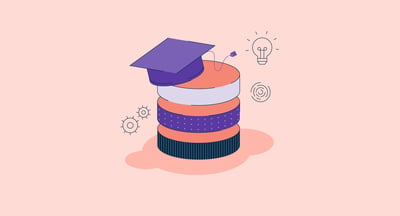We might have come across machine learning techniques like k-means clustering, random forest, or K-nearest neighbour. These are all forms of unsupervised learning.Whenever we are analyzing big data, we're exposed to large, unclassified, and unstructured data pipelines to work with. Here we can make use of unsupervised learning, which derives heuristics and feature mapping to find matches within heterogeneous data clusters for strategic forecasts.
If you are analyzing large volumes of unlabelled and unstructured data, working with analytics platforms can transform raw insights into calculated predictions and visualizations. Let's learn about unsupervised learning in detail.
Unsupervised learning is a machine learning technique that allows AI systems to identify patterns, relationships, and structures within data, without relying on labeled examples or human supervision. Rather than being told what to look for, the algorithm is left to explore raw, unlabeled datasets and draw its own conclusions.
This technique is particularly valuable in scenarios where manual labeling of data is costly, impractical, or simply impossible. From clustering customer personas to detecting anomalies in cybersecurity logs, unsupervised learning has emerged as a key pillar in the evolution of intelligent systems.
Unsupervised learning can be a goal in itself. For example, UL models can be used to find hidden patterns in massive volumes of data and even for classifying and labeling data points. The grouping of unsorted data points is performed by identifying their similarities and differences.
Unsupervised learning can be further divided into two categories: parametric unsupervised learning and non-parametric unsupervised learning.
Unsupervised learning plays a foundational role in the development of intelligent, scalable AI systems. Here's why it matters:
It also lays the groundwork for artificial general intelligence (AGI), systems that can learn across tasks without explicit instruction.
In unsupervised learning, an AI model receives raw input data without any accompanying output or guidance. Its job is to sift through this data, identify meaningful structures, and group or associate elements based on similarities and hidden relationships.
To illustrate this, consider a scenario where you're handed dozens of images of animals — but without any labels. If you're asked to sort them, you'd likely group similar animals together (cats, dogs, birds), even if you don’t know their names. That’s essentially what unsupervised learning does.
This approach contrasts sharply with supervised learning, where labeled datasets explicitly teach the model what the correct outputs should be. In unsupervised learning, the model must make sense of the data on its own.
The process typically begins with a data scientist preparing an unlabeled dataset. Algorithms such as k-means or Apriori then analyze the data to discover clusters, associations, or hidden variables. A classic example is analyzing customer purchase behavior to reveal natural groupings or buying patterns.
An everyday analogy? Imagine you're blind taste-testing two unknown sauces — ketchup and chili sauce. With repeated tastings, you'd learn to distinguish them based on flavor alone, eventually grouping future samples accordingly. That’s unsupervised learning in action.
Unsupervised learning problems can be classified into clustering and association problems.
Clustering or cluster analysis is the process of grouping objects into clusters. The items with the most similarities are grouped together, whereas the rest falls into other clusters. An example of clustering would be grouping YouTube users based on their watch history.
Clustering can be broken down into various techniques:
Association rule learning (ARL) uncovers relationships between variables in large datasets. Rather than organizing data into clusters, ARL identifies how the presence of certain elements predicts the presence of others.
For instance, if many customers who buy peanut butter also buy jelly, ARL captures that relationship. This is widely used in market basket analysis and recommendation engines.
Association rules are usually expressed with if/then statements and evaluated with:
Unsupervised learning uses a wide array of algorithms depending on the problem type:
The Apriori algorithm, ECLAT algorithm, and Frequent Pattern (FP) growth algorithm are some of the notable algorithms used to implement the association rule. Algorithms such as k-means clustering and principal component analysis (PCA) make clustering possible.
The Apriori algorithm is built for data mining. It's useful for mining databases containing a large number of transactions, such as a database containing the list of items bought by shoppers in a supermarket. It is also used to identify the harmful effects of drugs and in market basket analysis to find the set of items customers are more likely to buy together.
Equivalence Class Clustering and bottom-up Lattice Traversal, or ECLAT for short, is a data mining algorithm used to achieve itemset mining and find frequent items.
The Apriori algorithm uses a horizontal data format and so needs to scan the database multiple times to identify frequent items. On the other hand, ECLAT follows a vertical approach and is generally faster as it needs to scan the database only once.
The frequent pattern (FP) growth algorithm is an improved version of the Apriori algorithm. This algorithm represents the database in the form of a tree structure known as a frequent tree or pattern.
Such a frequent tree is used for mining the most frequent patterns. While the Apriori algorithm needs to scan the database n+1 times (where n is the length of the longest model), the FP-growth algorithm requires just two scans.
Many iterations of the k-means algorithm are widely used in the field of data science. Simply put, the k-means clustering algorithm groups similar items into clusters. The number of clusters is represented by k. So if the value of k is 3, there will be three clusters in total.
This clustering method divides the unlabeled dataset so that each data point belongs to only a single group with similar properties. The key is to find K centers called cluster centroids.
Each cluster will have one cluster centroid, and when the algorithm sees a new data point, it will determine the closest cluster to which the data point belongs based on metrics like the Euclidean distance.
The principal component analysis (PCA) is a dimensionality-reduction method generally used to reduce the dimensionality of large datasets. It does this by converting a large number of variables into a smaller one that contains almost all the information in the large dataset.
Reducing the number of variables might affect the accuracy slightly, but it could be an acceptable tradeoff for simplicity. Smaller datasets are easier to analyze, and machine learning algorithms don't have to work hard to derive valuable insights.
Understanding how unsupervised learning compares with supervised learning helps clarify their respective roles:
| Learning type | Data requirement | Human involvement | Strengths | Common use cases |
| Supervised | Labeled data | High | High accuracy, direct feedback | Image classification, spam detection |
| Unsupervised | Unlabeled data | None | Pattern discovery, no labels needed | Customer segmentation, anomaly detection |
| Semi-Supervised | Mostly unlabeled + few labels | Moderate | Balances performance and data efficiency | Text classification, medical image labeling |
| Reinforcement | Interactive environment | Indirect (via reward) | Learns optimal decisions over time | Robotics, game AI, recommendation systems |
Self-supervised learning (SSL) is rapidly gaining attention as a powerful approach that bridges the gap between supervised and unsupervised learning. It leverages the structure within unlabeled data to generate its own labels, allowing models to pre-train on massive datasets without requiring human annotation.
Unlike traditional supervised learning, which relies on manual labels, self-supervised systems generate pseudo-labels from the data itself. These can be used to predict the next word in a sentence (as in language models) or fill in missing parts of an image. Once pre-trained, these models can be fine-tuned for specific downstream tasks using a smaller labeled dataset.
SSL is particularly influential in the field of generative AI. Foundation models like GPT, BERT, and DALL·E rely heavily on self-supervised pretraining to learn rich, general-purpose representations of language or visual data. This approach has become the de facto standard for building scalable, adaptable AI systems.
As AI evolves toward more generalized intelligence, self-supervised learning is poised to become the dominant learning paradigm.
As mentioned earlier, unsupervised learning can be a goal in itself. It can be used to find hidden patterns in vast volumes of data, an unrealistic task for humans.
Some real-world applications of unsupervised machine learning.
G2 helps businesses find the best machine learning tools for building predictive models, accelerating experimentation, and operationalizing AI workflows across teams.
Below are the five best machine learning software, based on G2’s Winter 2026 Grid Report.
Got more questions? We have the answers.
Unsupervised learning is a machine learning approach where algorithms analyze unlabeled data to find hidden patterns and structures without human supervision. It’s widely used for tasks like grouping, pattern discovery, and anomaly detection.
The two main types are clustering (grouping similar data points together) and association rule learning (finding relationships between variables in large datasets).
Clustering works by analyzing similarities among data points and grouping them into clusters. Each cluster contains items with shared traits, such as grouping customers by purchase behavior.
Popular algorithms include k-means clustering, Principal Component Analysis (PCA), Apriori, ECLAT, and FP-Growth, each suited to different clustering or association tasks..
It’s used in fraud detection, customer segmentation, recommendation systems, market basket analysis, and image recognition for self-driving cars and healthcare.
Supervised learning relies on labeled datasets and produces higher accuracy for defined tasks, while unsupervised learning works with unlabeled data to explore unknown patterns and relationships.
Challenges include evaluating accuracy, requiring large datasets, and potential unpredictability in results. Models can also be harder to interpret compared to supervised approaches..
Self-supervised learning generates labels automatically from unlabeled data, serving as a bridge between supervised and unsupervised methods. It’s the foundation of modern generative AI models like GPT and BERT.
Unsupervised learning is indispensable in the modern machine learning toolbox. Its ability to parse massive amounts of unstructured, unlabeled data enables scalable insights and automated decision-making. While it may not always match supervised learning in accuracy or simplicity, its versatility and depth make it essential for exploring unknowns and uncovering hidden structures.
As AI systems push toward autonomy, the role of unsupervised learning will only grow. From reducing manual overhead to enabling real-time learning, this form of machine learning is carving the path toward more intelligent, adaptable systems.
And while we’re far from sentient machines, the unsupervised learning techniques we’re developing today are making narrow AI smarter, faster, and more useful than ever before.
Explore the differences between unsupervised and supervised machine learning techniques and map the efficiency levels in strategic prediction accuracy.
This article was originally published in 2021. It has been updated with new information.
Amal is a Research Analyst at G2 researching the cybersecurity, blockchain, and machine learning space. He's fascinated by the human mind and hopes to decipher it in its entirety one day. In his free time, you can find him reading books, obsessing over sci-fi movies, or fighting the urge to have a slice of pizza.
With the progression of advanced machine learning inventions, strategies like supervised and...
 by Alyssa Towns
by Alyssa Towns
Deep learning is an intelligent machine's way of learning things.
 by Amal Joby
by Amal Joby
Machine learning models are as good as the data they're trained on.
 by Amal Joby
by Amal Joby
With the progression of advanced machine learning inventions, strategies like supervised and...
 by Alyssa Towns
by Alyssa Towns
Deep learning is an intelligent machine's way of learning things.
 by Amal Joby
by Amal Joby


